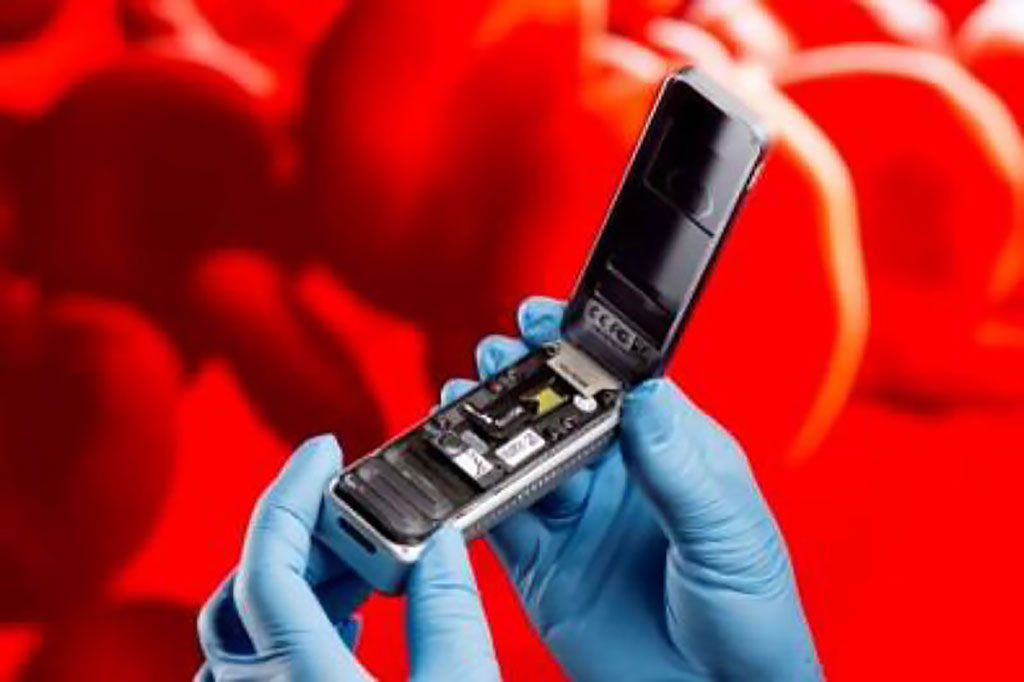Rapid Test Uses Nanopore Sequencing to Diagnose Sepsis by Detecting DNA Released by Pathogenic Microorganisms in the Bloodsteam
By LabMedica International staff writers
Posted on 17 Mar 2020
A team of German researchers has developed a rapid test to diagnosis sepsis by detecting DNA released by pathogenic microorganisms in the bloodsteam.Posted on 17 Mar 2020
Current diagnostic procedures for pathogen identification mainly depend on culture- and molecular-based approaches, which may not be satisfactory regarding specificity, sensitivity, and time to diagnosis. To correct this situation, investigators at the Fraunhofer Institute for Interfacial Engineering and Biotechnology (Stuttgart, Germany) and Heidelberg University Hospital (Heidelberg, Germany) developed a complete diagnostic workflow for real-time high-throughput sequencing of cell-free DNA from plasma based on nanopore sequencing for the detection of the causative agents.

Image: The MinION nanopore sequencer used for real-time microbial cell-free DNA analyses in septic patients (Photo courtesy of Fraunhofer Institute for Interfacial Engineering and Biotechnology)
Nanopore sequencing is a unique, scalable technology that enables direct, real-time analysis of long DNA or RNA fragments. It works by monitoring changes to an electrical current as nucleic acids are passed through a protein nanopore. The resulting signal is decoded to provide the specific DNA or RNA sequence. Using nanopore sequencing, a single molecule of DNA or RNA can be sequenced without the need for PCR amplification or chemical labeling of the sample. At least one of these aforementioned steps is necessary in the procedure of any previously developed sequencing approach.
For the current study, DNA detection and sequencing was carried out with the Oxford Nanopore Technologies (Oxford, United Kingdom) MinION system. Initially, eight samples from four septic patients and three healthy controls were analyzed and subsequently validated against results obtained by the Illumina (San Diego, CA, USA) next-generation sequencing technique.
The investigators then conducted a retrospective analysis of 239 samples taken from sepsis patients. Although the accuracy of nanopore sequencing was lower than with Illumina (approximately 85% vs. 99%), they found a strong correlation between the findings generated by MinION vs. Illumina.
The results suggested that reliable identification of pathogens based on circulating cell-free DNA sequencing using optimized workflows and real-time nanopore-based sequencing could be accomplished within five to six hours following blood draw.
"With up to 50 million incident sepsis cases and 11 million sepsis-related deaths per year, sepsis represents a major cause of health loss," contributing author Dr.Thorsten Brenner, vice-head of anesthesiology at Heidelberg University Hospital. "Reliable and early identification of the pathogen enables rapid and the most appropriate antibiotic intervention, thereby increasing the chance of better outcomes and patient survival. Currently, standard-of-care diagnostics still rely on microbiological culturing of the respective pathogens, which in most cases (70 to 90%) do not provide timely positive results."
"Time consuming, error- and contamination-prone blood cultures are still considered as the standard of care for sepsis diagnostics, frequently leading to an inappropriate and delayed targeted therapy," said Dr. Brenner. "The nanopore sequencing platform sequences in real time and has the potential to reduce time to diagnosis to only a few hours."
The sepsis detection paper was published in the March 2020 issue of the Journal of Molecular Diagnostics.
Related Links:
Fraunhofer Institute for Interfacial Engineering and Biotechnology
Heidelberg University Hospital
Oxford Nanopore Technologies
Illumina














